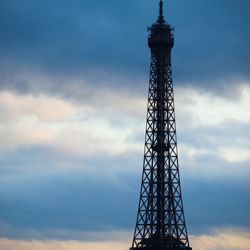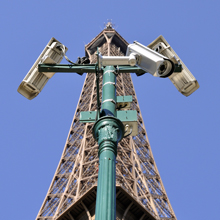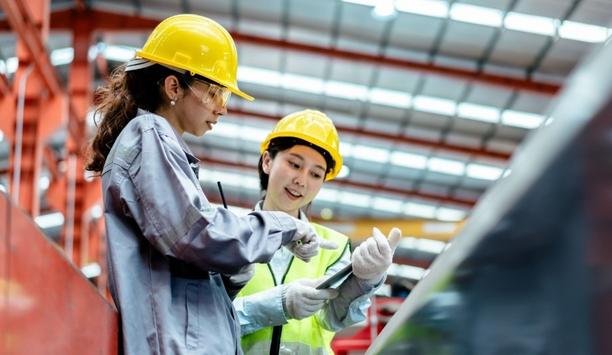 |
Right after the Paris terrorist attacks, a headline I read throughout the media asked: “Did intelligence services drop the ball?” The question has a familiar ring, and you’ll find variations on it throughout the last and present centuries concerning events that range from presidential assassinations to 9/11, 7/7 in London and the 2008 Mumbai bombings.
But physical security, rather than information gathering, is our scope here. From the moment I saw thermal imaging cameras being used from helicopters to track the movements of the Kouachi brothers through a forest in Picardy, I thought of the advertising slogans used by camera manufacturers to the effect that you can’t hide your body heat.
Access control failed the journalists and other victims at the offices of Charlie Hebdo under extraordinary circumstances in which cartoonist Corine Rey was forced (at the end of the barrel of a Kalashnikov) to type her access code into a keypad after gunmen threatened to kill her toddler daughter. Biometric safeguards might have prevented the incursion by the terrorists. However, with the magazine having just published an edition whose front cover features a cartoon of the Prophet Muhammad, it’s a safe bet to say that this is an organisation whose staff is unlikely to be cowed into a restrictive regime that would impede their core business of producing a satirical magazine. It should also be noted that our normal perspective of access control at commercial premises is irrelevant in the face of jihadists armed with an RPG and Molotov cocktails.
While defiant in their willingness to satirise Islam, the Charlie Hebdo staff was not wilful in flouting the usual dictates of security. Knowing that a meeting attended by their editor and all their principal cartoonists was a potential flashpoint, they had a police officer present. (He was among the fatalities.) In 2006, Charlie Hebdo was among a handful of publications worldwide to reprint unpixelated versions of cartoons depicting the Prophet that had originated from the Danish newspaper Jylland-Posten, and in 2011 its Île-de-France headquarters was fire-bombed after the Prophet was depicted on a front cover.
From the viewpoint of CCTV, it’s interesting to note that police were able to “hijack” the IP camera feeds from the Hyper Cacher kosher supermarket in an eastern suburb of Paris on the Friday and glean information on the unfolding crisis as Amedy Coulibaly held hostages inside. While insecure and vulnerable CCTV may remain a concern in our industry, the police’s ability to monitor this footage without alerting Coulibaly may have helped to save lives when the shop was finally stormed by 30 elite armed officers. There is irony in the fact that cameras that must have been installed merely to guard against low-grade retail shrinkage proved crucial in a worldwide news story.
At one time thought to be in the supermarket with Coulibaly, his partner Hayat Boumeddiene (now the world’s most wanted woman) has been seen on good quality CCTV footage dating from 2 January at an airport in Istanbul, Turkey, on her way to Syria, which she entered the day before her partner took control of the supermarket and the day he shot a police officer.
 |
| There is likely to be more transparency and genuine debate on the full range of physical security measures in France |
So what’s the likely impact of the magazine and supermarket attacks on physical security measures in France? Former president Sarkozy indicated that he wanted “vidéoprotection” to go mainstream, and he set a target of increasing the number of nationwide public space video cameras from 20,000 to 60,000. Research by Paris-based Cnil suggests that 71 percent of French citizens approve of public space CCTV, although the Interior Ministry has said it is keen to avoid indiscriminate “Anglo-Saxon-style” urban surveillance. Surprisingly, the CCTV debate in France has divided down political lines with socialist mayors in Nice and Carcasonne being in favour of security cameras.
Sarkozy’s successor, François Hollande, has 17 deaths and 21 injuries (many of them critical) on his watch. The Mairie de Paris (the Paris municipal administration) has embarked on a €200m programme that is giving police access to 13,000 public and private cameras, a number that presumably includes those vital video feeds from the Hyper Cacher supermarket. The 20 police stations in the capital will all have a surveillance room giving access to the central control room in the Île de la Cité that includes the Charlie Hebdo office. (It should be noted that the magazine’s staff is currently working from a temporary office at a sister publication under a massive security operation.)
As he battled last week with the worst terrorist incident in France since paramilitaries opposed to Algerian independence bombed a Strasbourg-to-Paris train in 1961, Bernard Boucault (Préfet de Police) could exploit an increasingly widespread and sophisticated CCTV system. Many of the new cameras have been installed around the Paris arrondissements with their targets being accident black spots, major public spaces and areas known for delinquency. The country remains opposed to ANPR (license plate recognition), and while 1,000 new roadside cameras have been installed, few of these scan number plates since the French prefer to integrate the technology into machine vision devices within gendarmerie and customs police vehicles. There is widespread distrust of ANPR cameras, and they are rare. The fact that the Kouachi brothers were able to use three different cars (two of them stolen) and, by my reckoning, cover at least 200 miles without detection may now reduce opposition to highway license plate scanning.
As I type this, Richard Malka, a lawyer for Charlie Hebdo has declared that the magazine will “cede nothing to terrorists,” and the government is sending 10,000 troops to protect possible trouble spots such as synagogues, Jewish schools and mosques. Watching what has been estimated as a crowd of 1.5 million people taking to the streets of Paris on Sunday, I noticed many banners declaring “We love the police.” French equivalents of “Big Brother Watch” have lost significant ground in recent days as cameras have proved their worth, and there is likely to be more transparency and genuine debate on the full range of physical security measures in France, extending beyond CCTV to biometric access control and perimeter intrusion prevention.
More on this story
Paris terrorism attacks reflect a problem larger than us
Looking at security in light of the Paris attacks










































